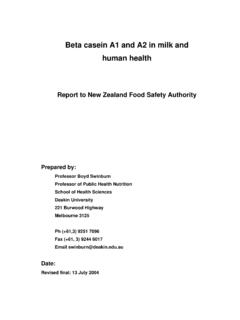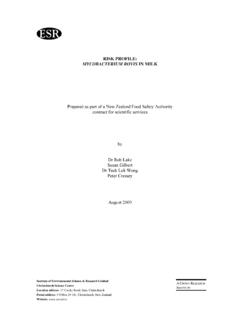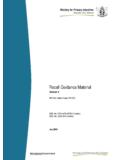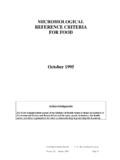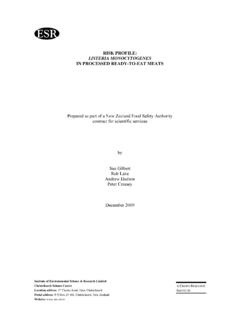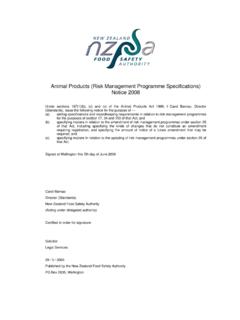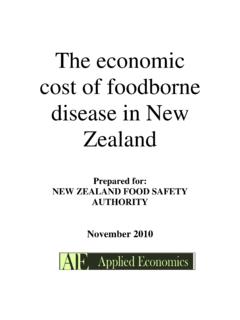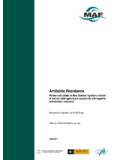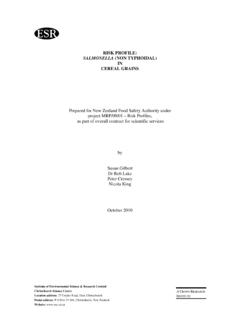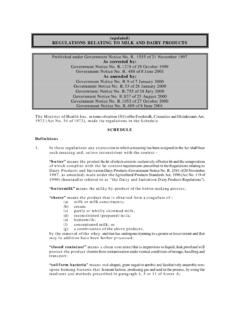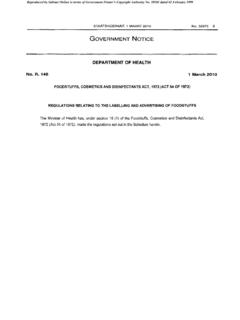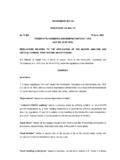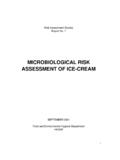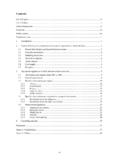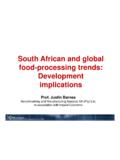Transcription of Operational Guideline: Design and Construction of …
1 Te Pou Oranga Kai O Aotearoa Operational Guideline: Design and Construction of dairy Premises and Equipment 13 April 2006 New Zealand Food Safety Authority PO Box 2835, Wellington, New Zealand 13 September 2005 2 Acknowledgments NZFSA wishes to acknowledge the contribution from the dairy industry in the review/development of this code into guideline format. 3 Table of Contents Introduction .. 4 New or Significantly Altered dairy Premises and/or Plant .. 10 Layout of the 16 Layout for Buildings.
2 17 Design and Construction of Buildings .. 23 Building Services .. 31 General Requirements for Manufacturing Equipment .. 41 Layout of Manufacturing 45 Process engineering .. 47 Requirements for Specific Types of Equipment .. 53 Introduction Background to the Development of this Guideline Criteria relating to the Design and Construction of dairy Premises and plant were originally published by MAF within the documents DDM1A, DDM1B, DDM1C. The ownership of these documents was then transferred to MQM and the documents were renamed as MQD1A, MQD1B, MQD1C.
3 These precursor documents were then reviewed by an industry working group and published by the New Zealand dairy Board (NZDB) as NZCP6 ( Design and Layout of Manufacturing Premises) This review was funded by the NZDB, and copyright was vested with the NZDB. NZCP6 was approved by MAF as a Code of Practice for the NZ dairy Industry. It was, and is, widely regarded within the NZ industry as a benchmark for the Design and Construction of dairy Plants and Premises. In 2005, Fonterra transferred copyright of NZCP6 to NZFSA.
4 This transfer has enabled NZFSA to review the document and to develop the NZFSA Guideline for the Design and Construction of dairy Premises and Equipment. What is the purpose of this guideline? All operations involving dairy material processing intended for export must be conducted in accordance with the requirements of an approved Risk Management Programme. The approval of the RMP will include consideration of the issues covered in this Guideline ( buildings, equipment, building services and amenities).
5 This guideline does not cover laboratories, farm dairies or stores. [Location will be advised as become available]. This purpose of this guideline is to provide information to dairy stakeholders concerning the production of safe product with regard to the following areas: Technical guidance material, regarding the Design , Construction and approval of dairy premises, by which the RMP can be deemed to be compliant in the areas of premises and equipment NZFSA prior evaluation process of sections of the RMP relating to premises and plant Design and Construction .
6 Note that this prior approval process is a non mandatory process developed to assist the dairy industry. It is recommended that the prior evaluation process is followed in order to minimise the risk of potentially costly conditions being imposed at time of RMP assessment. This guideline should be read in conjunction with relevant market requirements ICR s/OMARS. It is intended that this guideline be applied to new or significantly altered premises or plants. 5 What is included in this guideline?
7 This guideline sets out standards and guidelines for the Design and Construction of premises and equipment used for the manufacture and processing of dairy products and transport of bulk milk and liquid milk products. This guideline is relevant to the requirements of the Animal Products Act 1999. Whilst this document is prepared for the dairy industry, it may provide assistance to other food manufacturers. Food premises will also need to comply with other regulatory requirements ( OSH) and specific processing requirements and the requirements of local authorities, especially the Resource Management Act 1991 and the Building Act 1992.
8 This guideline provides technical information for the hygienic Design and Construction of dairy manufacturing premises and equipment. It also satisfies NZFSA requirements for RMP approval. What are the desired outcomes? It is expected that after reading this guideline dairy processors will have gained technical information regarding the requirements for hygienic Design and Construction of premises and equipment. Conformance with the technical material in this guideline will facilitate RMP approval in the areas of premises and plant Design and Construction .
9 Glossary of terms These definitions must be read in conjunction with the interpretations in the Animal Products Act 1999 and the Animal Products ( dairy ) Regulations 2005. NZFSA definitions of terms can be found in the Glossary of Terms, available on the dairy & Plants website ( ). dairy Material means animal material that is - - milk extracted from a milking animal - any material derived or processed from milk extracted from a milking animal, up until delivery of the material at the place of sale for consumption or for end use for purposes other than consumption, or its export; and - includes dairy product that, having been purchased or imported, is further processed.
10 Equipment means all apparatus, containers, conveyances, machinery, piping, pumps, utensils, vehicles, and other things used in the transport, reception, testing, grading, manufacture, or storage of milk . 6 Fit for intended purpose The phrase fit for intended purpose , used in relation to animal product that has been processed in accordance with Parts 2 to 4, means that, by reason of animal material or product having had the relevant risk factors managed in accordance with Parts 2 and 3, and meeting any relevant animal product standards and associated specifications set under Part 4.

